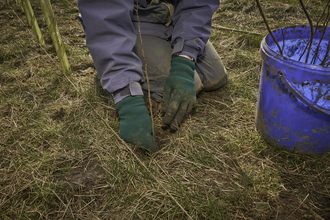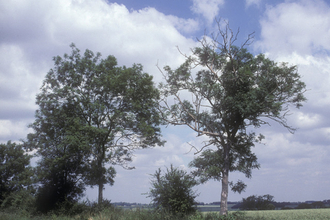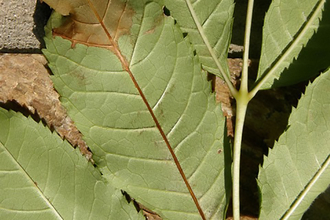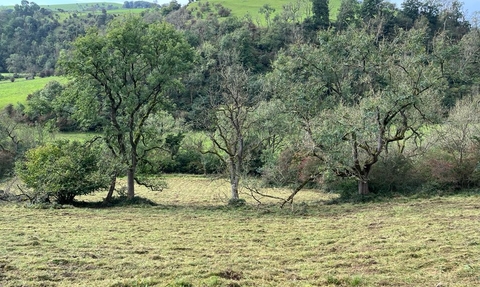
Ash dieback
A fatal fungal disease of ash trees
First confirmed in the UK in 2012, ash dieback, also known as 'Chalara' or Chalara ash dieback, is a disease of ash trees caused by a fungus called Hymenoscyphus fraxineus.
This disease has spread quickly and is now affecting woodlands across the UK, leading to the death of thousands of trees. It has already caused widespread damage in continental Europe.
How is Staffordshire impacted?
The Trust manages more than 1,900 hectares of land in Staffordshire including many reserves with woodland and trees. Surveys across the woodlands have identified that extensive areas of ash trees are infected by the disease. The Trust has removed some dangerous or fallen ash trees from areas including footpaths already and the concern is that these numbers will increase.
As our reserves are very popular with local people and visitors, public safety is a key concern. The Trust is carrying out an assessment of affected woodlands in line with updated guidance from the Forestry Commission and the National Tree Safety Group’s ash dieback guidance.
As such the Trust has determined that the selective felling of affected ash trees which stand beside public footpaths, bridleways, roads and other high-risk features is the most appropriate action.
A specialist team are also working at our White Peak reserves in the Peak District through a funded restoration project called Life in the Ravines. You can read more about this on their page below.
What is ash dieback?
Ash dieback is a disease that affects ash trees, caused by a fungus called Hymenoscyphus fraxineus. The fungus has two stages to its lifecycle - a sexual stage, which helps the fungus spread, and an asexual stage, which is what grows on the tree and causes damage. The fungus blocks water transport in the tree, leading to lesions in the bark, leaf loss and the dieback of the crown.
Ash dieback fungus is believed to have originated in Asia. It was first discovered in Europe in Poland in 1992 and is now found widely across the continent. The first confirmed case in the UK came in 2012, since then it has spread across England and to Scotland, Wales, Northern Ireland, and the Isle of Man.
Ash dieback symptoms
The main symptoms of ash dieback are:
- Dead branches
- Blackening of leaves which often hang on the tree
- Discoloured stems often with a diamond-shape lesion where a leaf was attached
Trees may eventually drop limbs, collapse or fall. The symptoms are often easier to spot in mid-late summer when a healthy ash should be in full leaf. It becomes much harder in autumn when leaves are naturally changing colour and falling.
Once a tree is infected the disease is usually fatal, either directly, or indirectly by weakening the tree to the point where it succumbs more readily to attacks by other pests or pathogens, such as honey fungus. These secondary pathogens can cause butt or root rot, leading to the tree falling.
Why is it so dangerous?
The disease makes ash trees more susceptible to secondary diseases such as honey fungus, which in turn makes them more vulnerable to other stress factors, thereby increasing the likelihood of these trees falling or shedding branches. We have also found that trees which appear only lightly infected by Ash Dieback can collapse or have large and heavy branches fall without warning.
How does it spread?
The disease may spread locally (over tens of miles) by wind dispersal. The reproductive stage of the fungus grows on the previous year's fallen leaves, producing fruiting bodies that release spores between June and September. The wind disperses these spores and settles on the leaves of healthy trees. If a healthy tree receives a high enough dose of spores, it too will become infected. Over longer distances, the disease may be spread by the movement of infected ash plants.
Management
There is no cure for ash dieback, but some trees are less susceptible to the disease. Investigating this natural resistance could be the best way to secure the future of the UK's ash trees. Ash dieback causes trees to die, drop limbs, collapse or fall. In places where infected trees grow beside roads and footpaths, they are likely to pose a threat to public safety. As a result, in some cases, infected ash trees are removed for the safety of site users and to help control the spread of the disease. In these cases, ecological surveys are important to check for the presence of protected species such as badgers and dormice, enabling the appropriate mitigation to be undertaken. In some woodlands, impacted ash trees will be left as standing deadwood where there is no public safety risk. Deadwood is an important part of a healthy woodland ecosystem as it provides habitat and food for many invertebrates, bats, birds and mammals.
What you can do
Biosecurity is important to help manage the spread of the disease. Simple steps such as washing your footwear before and after walking in woodland, sticking to footpaths and washing bike and car tyres can all help reduce the risk of spores being spread.
What's happening on our Nature Reserves
Sadly Ash die back is affecting many of our nature reserves in Staffordshire. We have already had to carry out some felling in some of our woodlands and over the next few years we will have to continue to do so.
Hem Heath
Tree safety works and ash-felling work will be carried out this winter (2023). The contractors will be felling diseased ash trees and removing the timber. They will be concentrating on high-risk areas along the footpath network. While they are carrying out the work paths will be temporarily closed and there will be reduced parking availability in the car park. We would like to thank you in advance for your cooperation while this work is being carried out and request that you adhere to the temporary path closures in the woods.
Loynton Moss
We carried out some ash felling works and timber extraction in the winter of 2021-2022. Unfortunately, we will have to carry out more ash-felling work in autumn/winter 2024/25. We will be concentrating on trees in high-risk areas - particularly those that are within falling distance of the bridleway and paths. We have also made the difficult decision to close a section of the woodland to the public where the diseased ash trees are (see map below) for the foreseeable future. We thank you for your cooperation and understanding.
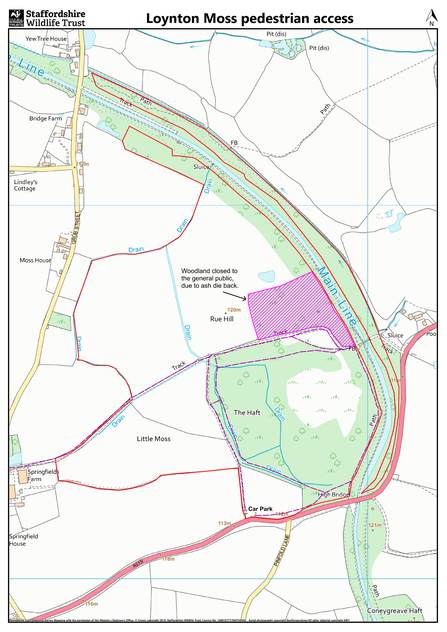
George's Hayes
We will be carrying out the felling and timber extraction of diseased ash trees, many of which are along the roadside at George's Hayes Woods from 2023. This is a high-risk area and the work is being carried out for safety reasons. There will also be some thinning of the sycamore trees in Georges Hayes to allow more light onto the woodland floor to help encourage the wild daffodils and garlic to spread through what are currently quite dark areas. Thank you for your understanding and cooperation.
Castern Wood
As part of the LIFE in the Ravines project in the White Peak, we have been thinning sections of impacted ash woodland and replanting them with other native broadleaf trees.

